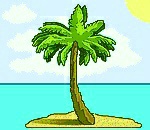
 |
itsislandtime > Trinidad and Tobago > Trinidad and Tobago Information | |
| itsislandtime.com | ||
|
Trinidad and Tobago |
|||||||||||
By Beachcomber, retrieved from Wikipedia Nov 4, 2003, 11:21 The Republic of Trinidad and Tobago is a nation located in the southern Caribbean Sea, off the coast of Venezuela. It consists of two islands, Trinidad and Tobago. The larger and more populated island is Trinidad, while the island of Tobago is a lot smaller and less populous. The tallest building in Trinidad and Tobago is the recently constructed Nicholas Tower.
Little is known of the history of the islands before they were discovered by Christopher Columbus on July 31, 1498. He named Trinidad after the Holy Trinity; Tobago was named Bella Forma by him, but this later became Tobago (probably derived from tobacco). The Spanish settled on Trinidad, while Tobago frequently changed hands between the European sea powers, but the settlements on both islands were small and underdeveloped. The changing of hands of the European powers was mainly to keep Tobago free of pirates. In the 18th century, Britain acquired both islands, and they were combined into the colony of Trinidad and Tobago in 1889. Following World War II, when American naval bases were located on Trinidad, the islands became independent as part of the West Indies Federation in 1958. The federation was dissolved quickly, and the independent nation of Trinidad and Tobago was formed in 1962. In 1976 the country severed its links with the British monarchy and became a republic within the Commonwealth. At present, the country is one of the most prosperous in the Caribbean, thanks largely to petroleum and natural gas production and processing. Tourism, mostly in Tobago, is targeted for expansion and is growing.
Chief of state in Trinidad and Tobago is the president, Professor George Maxwell Richards, who is elected by the parliament. This parliament consists of two chambers, the Senate (31 seats) and the House of Representatives (36 seats). The members of the former are appointed by the president,the ruling party and the Opposition, while the members of the latter are chosen by the public in elections held every five years. The Prime Minister, who heads the House of Representatives, is chosen by the president; usually the leader of the largest party is chosen. The present ruling party (2004) is the People's National Movement led by Patrick Manning; the Opposition is the United National Congress led by Basdeo Panday.
The terrain of the islands is a mixture of mountains and plains. The highest point in the country is found on the Northern Range at El Cerro del Aripo which is situated at 940 m above sea level. The climate is tropical. There are two seasons annually. The dry season, for the first six months of the year, and the rainy season, in the second half of the year. The rainy season is also known as the Hurricane season, however unlike most of the other Caribbean islands, Trinidad and Tobago have frequently escaped the wrath of major devastating hurricanes. Trinidad and Tobago are supplied with the North Westerly winds which blow from the north west of the islands to the south east of the islands. As the majority of the population live in Trinidad, this is the location of most major towns and cities. There are two major cities in Trinidad: Port of Spain, the capital, and San Fernando. Although not usually recognised as such, the largest town on the island is actually Chaguanas, which is also the fastest-growing region. The largest settlement on Tobago is Scarborough. Trinidad is made up of a variety of soil types, the majority being fine sands and heavy clays. The alluvial valleys of the Northern Range and the soils of the "East-West Corridor" being the most fertile.
Trinidad and Tobago has earned a reputation as an excellent investment site for international businesses. A leading performer the past four years has been the booming natural gas sector. Tourism is a growing sector, although not proportionately as important as in many other Caribbean islands. The economy benefits from low inflation and a trade surplus. The year 2002 was marked by solid growth in the oil sector, offset in part by domestic political uncertainty.
The two predominant ethnic groups are Indo-Trinidadians, the descendants of indentured labourers from India (40.3% of the population) and Afro-Trinidadians who descend from African slaves (39.5%). Together the two groups form about 79.8% of the population; most of the remainder are people of mixed descent, with small minorities of Europeans, Chinese, Syrian-Lebanese and Caribs (descendants of the indigenous inhabitants, not recognized as a distinct census category). Many different religions are present in Trinidad and Tobago. The largest two are the Roman Catholic Church and Hinduism; the Anglican Church, Islam, Presbyterian Church and Methodist Church are among the smaller faiths. English is the country's only official language, but Hindi is also spoken by some Indo-Trinidadians. Patois (a dialect of French Creole) is rarely spoken. Due to Trinidad's location on the coast of South America, the country is slowly developing a connection with the Spanish-speaking peoples, and therefore many schools now teach Spanish to the locals.
Trinidad and Tobago are famous as the birthplace of the calypso music, as well as the music of the steel pan (whose patent is held by someone in Maryland, United States). The diverse cultural and religious background allows for many festivities and ceremonies throughout the year. Other indigenous art forms include chutney, soca, Parang, and pichakarie (musical forms which blend the music of the Caribbean and India) and the famous limbo dance. Click here for the full Wikipedia article.
|